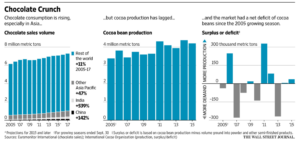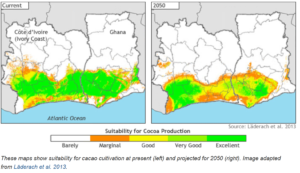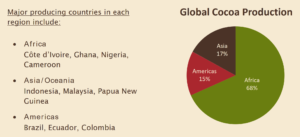“The Chocopalyse”: Imagine a World without Chocolate

Valentine’s Day without a heart box filled with chocolates? Easter without a solid chocolate Easter Egg? Halloween without Reese’s Peanut Butter Cups? Hanukkah without Gelt? It is hard to imagine such a world, but the sad reality is these celebrations may in the future no longer include chocolates. Unless companies help farmers to drastically change the way they are producing cocoa beans, climate change may make enjoying chocolate an expensive, difficult task.
The Situation
With chocolate consumption rising in areas such as Asia and cocoa production slowing in large part due to climate changes, a pretty strong deficit of cocoa beans has resulted which chocolate manufacturers are trying to address (Figure 1)1.
Figure 1: The Chocolate Crunch1
Cocoa beans grow in warm, humid areas of the world. Unfortunately, with global warming advancing, many places where cocoa beans previously flourished may become unsuitable for cocoa bean growth as they grow warmer, grow drier, and have decreased precipitation2.
Figure 2: Elevation Changes Expected for Cocoa Bean Growth3
While climate change has already affected cocoa bean growth, this impact is only expected to get worse with time. A 2011 study was done by the International Center for Tropical Agriculture (CIAT) which reaffirmed this, showing that soon Ghana and Cote d’Ivoire will become unsuitable for cocoa growing. By 2050 it is expected that rising temperatures will make uphill the only place cultivable for cocoa plant, rising from 350-800 ft up to 1500-1600 ft, into hilly regions (see Figure 2)3. As the map demonstrated, this is true in Ghana’s Atewa Range; however, the government will not allow cultivation of cocoa beans and farming in this region because the natural habitat is protected. The government will eventually have to decide between the lesser of two evils: either losing a huge part of their cash crop business or preserving their natural habitats.
With climate change, there has been a movement towards moving cocoa bean production to climates that have higher precipitation growth. For example, in recent history, Central American farmers have focused primarily on coffee trees, but with changing climates the land may be put to better use shifting to cocoa beans. While some companies have started moving their production to other climates such as Central America, this is not a possibility for companies like Hershey’s that produce high volume and low margin goods since the emphasis in this region is on quality over quantity4.
Figure 3: Split of Countries Producing Cocoa Beans5
This disruption will directly affect the livelihood of many farmers in developing countries, where most of the cocoa beans are grown (see Figure 35). Currently more than 10 million West Africans depend on cocoa for a large piece of their families’ income6. Approximately 80-90% of cocoa beans come from small, family-run farms (world cocoa); many of these family farmers use cocoa beans as ATMs – where they can easily grab pods and sell them quickly when they need cash to pay for expenses7. In fact, the disruption has already started with farmers in Ghana unable to grow the pods on their trees to maturity; the pods are instead shriveling even if the cocoa tree is closer to maturity1.
What should Hershey Do?
Hershey decided to take preventative action by helping to both improve the farmer production and raise cocoa bean production workers’ incomes. Hershey launched the Learn to Grow program in 2012 in Ghana, where they have been using cocoa beans for producing Hershey’s Kisses and Reese’s Peanut Butter Cups from for 50+ years. Andy McCormick, the Senior Director of Cocoa Sustainability at The Hershey Company, stated that Learn to Grow “provides cocoa farmers with business skills and good agricultural practices”6. Hershey also provides farmers with resources such as fertilizers and modern farming devices. This program was expanded to Nigeria in 2013 to improve water and power provision strategies there as well6.
Another method they are helping the farmers in Ghana is through an initiative called CocoaLink, where Hershey is providing mobile phones to farmers. CocoaLink provided a way for farmers to communicate with one another and showed that “yields, adoption of farm practices, and acquisition of useful social and health information by those farmers who used” were statistically significantly improved6.
While Hershey has done their best to help farmers feeling the effects of climate change, they are also doing their best to combat further exacerbating climate changes through a variety of initiatives ranging from reducing packaging materials, to investing in water efficiency, to bringing down greenhouse emissions and slowing deforestation8. Some of their tangible targets include reducing their greenhouse gas emissions by 50% by 2025 and reducing water use by an additional 25% by 2025 (8).
Word Count (772)
Bibliography
- http://www.wsj.com/articles/chocolate-makers-fight-a-melting-supply-of-cocoa-1452738616
- http://www.sustainablebrands.com/news_and_views/collaboration/hannah_furlong/hershey_lindt_mars_nestle_join_new_program_help_cocoa_fa
- https://www.climate.gov/news-features/climate-and/climate-chocolate
- http://www.reuters.com/article/us-climatechange-cocoa-coffee-idUSKCN0UW1AV
- http://www.worldcocoafoundation.org/wp-content/uploads/Cocoa-Market-Update-as-of-4-1-2014.pdf
- http://corporatecitizenship.bc.edu/blog/2014/04/hersheys-learn-to-grow-builds-opportunities-for-cocoa-farmers-through-evidence-based-learning-and-innovative-solutions
- https://www.scientificamerican.com/article/climate-change-could-melt-chocolate-production/
- https://www.thehersheycompany.com/en_us/responsibility/good-business/environmental-sustainability.html






Lindsey- I think you did a great job at highlighting the impact that this will have on real people— with 10M people dependent on this industry to make a living, the implications are huge! With these people out of work, the effect would be enormous on the West African economy.
The CocoaLink initiative you mentioned fascinated me— educating farmers via improved communication is such a creative solution to this problem. This initiative requires farmers to have a baseline understanding of the best practices, so I wondered whether Hershey has invested in a more educational element. While communication is a great step, I feel that Hershey could take a more direct approach to teaching farmers best practices vs. having them figure it out on their own together. Is this educational component a part of the Learn to Grow program you mentioned? If so, I think this should be the focus of Hershey’s efforts.
I wondered whether you thought Hershey’s targets to reduce greenhouse gases and water usage by 2025 were attainable. Are they on track? What might stand in their way?
Who would have thought that even our precious chocolate would be on the chopping block as a result of climate change! Thanks for bringing this to light… it really makes me realize how nearly every business will inevitably be impacted by this.
While it’s nice to hear that Hershey is making some effort to alleviate the pain cocoa farmers feel from changing climate, their actions do very little to sustainably address the core issue. I’m wondering what they could do in terms of growing technology (see this article by “soup”: https://d3.harvard.edu/platform-rctom/submission/can-extreme-tomato-farming-save-the-planet/) or even if enter into the business of genetically modified trees that could grow the beans in warmer conditions. Here is an interesting article on this: http://www.slate.com/articles/technology/future_tense/2012/04/heat_resistant_seeds_ecological_agriculture_growing_food_after_climate_change_.html
Thanks for helping us learn about this!
I agree with Chris – would be interesting to see if cacao producers have been considering modified or coated (a la Indigo) seeds that could help the seeds grow in drier conditions. There also appears to be a practice called cabruca in which planting (or retaining) trees to provide shade to the cacao trees could reduce temperature and evapotranspiration[1].
The situation you have described in Ghana makes it sound like they are in a tough place – do you have a sense of how aware they are of the issue/what steps they are taking to address it? For example, is the government considering other crops that current cacao farmers could shift to in order to maintain their livelihoods? Or have they begun discussions on how to weigh the trade-offs between preserving the protected land and maintaining their cacao production? Do the farmers themselves know what is likely to happen over the next few decades?
[1] Michon Scott, “Climate and Chocolate”, Climate.gov, February 10, 2016, https://www.climate.gov/news-features/climate-and/climate-chocolate, accessed November 2016.
Lindsey, I am horrified to hear that cocoa beans are in danger – talk about a call to action! Thanks for sharing your perspective on this unique topic. I agree with your recommendations, but for the sake of discussion let me offer a (likely unpopular) alternative.
If I take my “save the world” hat off for a moment, and think exclusively about how to sustain Hershey’s performance in light of these impending climate-change impacts to cocoa crops, I start thinking about cocoa as just another production input. If I were running a supply chain and one of the production inputs was at risk (a la cocoa), I would find more stable substitutes and switch to those. Enter, cocoa butter equivalent (http://uk.reuters.com/article/uk-asia-cocoa-substitute-idUKKBN0H00CB20140905). Cocoa butter equivalent, made from palm oil, tastes like cocoa butter and costs less.
While as a consumer I cringe to imagine yet another substitute in the high fructose corn syrup world we live in, this may be an essential part of adapting to climate change constraints for Hershey. While the pushback to this idea will of course be that consumers would reject it, we should realize that this is the same story as sugar and corn syrup: while a vocal minority might reject the change, the mass market likely doesn’t care. They just want their Hershey bars available on store shelves at the low prices they’re used to…which is what we may have to give them in a climate-change world using cocoa butter equivalent.